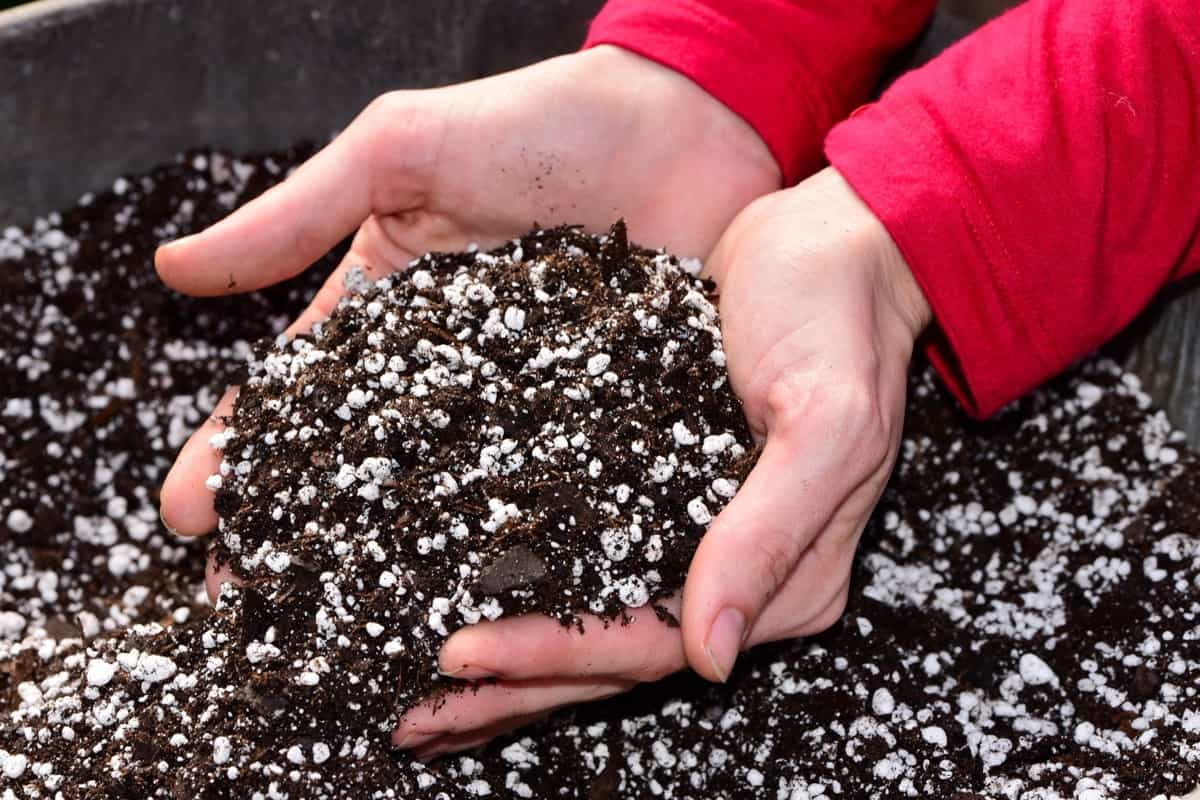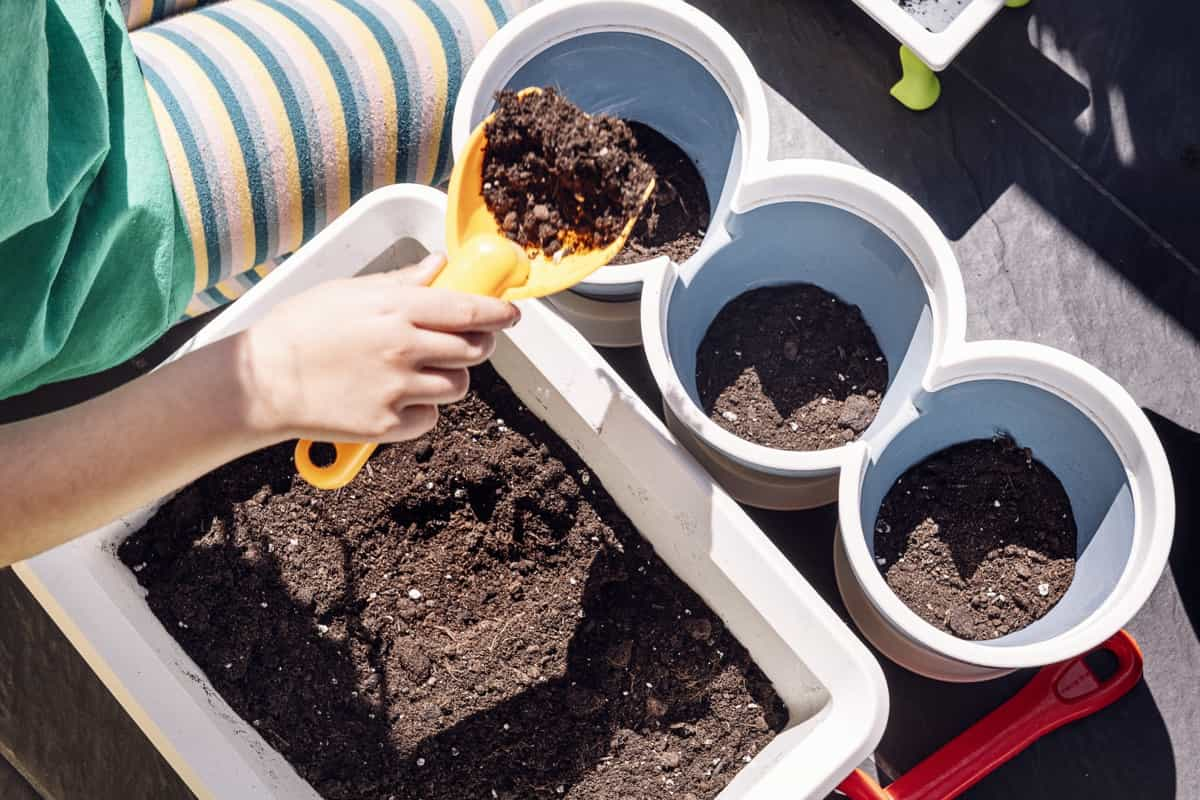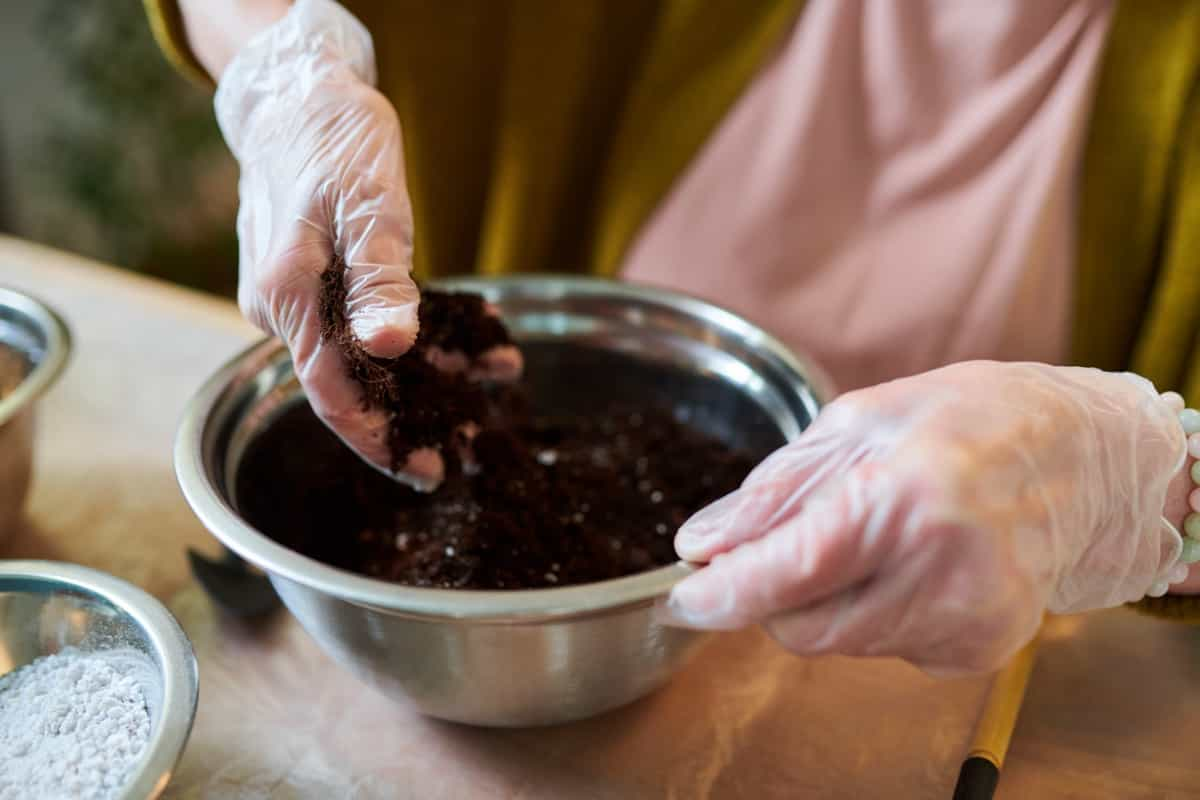By using the right ingredients, measuring properly, and adjusting for different types of plants, you’ll be well on your way to creating the perfect potting soil. Remember, quality potting soil is essential for providing plants with the nutrients they need to thrive. By avoiding these common mistakes, you’ll be able to create a nutrient-rich blend that promotes healthy root development and overall plant growth. Experiment with different recipes until you find the perfect mix for each type of plant in your garden.

Mistakes to Avoid When Mixing Your Potting Soil
Neglecting Proper Drainage
When it comes to mixing your potting soil, one common mistake that many gardeners make is neglecting proper drainage. Ensuring good drainage is crucial for the health and vitality of your plants. Waterlogged soil causes root rot and other issues, which will ultimately hinder the growth of your plants.
One way to improve drainage in your potting soil is by adding materials such as perlite or coarse sand. Another factor to consider is the type of container you use for your plants. Containers with drainage holes allow water to escape. Remember, when it comes to potting soil, excess moisture can be just as detrimental as not enough. So don’t overlook proper drainage if you want healthy and thriving plants.
Overlooking Soil Texture
When it comes to mixing your potting soil, one common mistake that many gardeners make is overlooking the importance of soil texture. If you neglect to consider soil texture when creating your potting mix, you may end up with a blend that is too compacted or drains poorly. On the other hand, if you use a mix with overly coarse particles, water may drain too quickly without being properly absorbed by the roots.
To avoid these problems, it’s essential to strike a balance in your potting mix by incorporating materials with different particle sizes. Mixing components like peat moss or coconut coir (to improve moisture retention), perlite or vermiculite (for better drainage), and compost (to provide nutrients) can help create an ideal texture for optimal plant growth.
Ignoring pH Levels
One of the common mistakes many gardeners make when mixing potting soil is ignoring the importance of pH levels. Different plants have different pH preferences, so it’s crucial to understand what your specific plants require. Ignoring this factor can lead to stunted growth, yellowing leaves, and poor nutrient absorption. Once you know the current pH level, adjust it accordingly by adding amendments like lime to raise the pH or sulfur to lower it.
In case you missed it: Best Ways to Rejuvenate Old Potting Soil

Using Poor Quality Ingredients
When it comes to mixing your potting soil, one mistake you want to avoid is using poor-quality ingredients. Your plants deserve the best, and that starts with the soil they’re planted in. Using low-quality ingredients can have a detrimental impact on your plants’ health and overall growth. Additionally, poor-quality ingredients might lack the essential nutrients necessary for plant growth.
To ensure optimal results, always opt for high-quality components when creating your potting mix. Invest in good-quality compost or organic matter to provide your plants with the necessary nutrients and improve soil structure. Remember, using poor-quality ingredients not only puts your plants at risk but also hinders their ability to thrive and flourish.
Overcomplicating the Mix
When it comes to mixing your potting soil, simplicity is key. One common mistake that many gardeners make is overcomplicating the mix. They think that by adding a multitude of ingredients and additives, they will create the perfect soil for plants. However, this often leads to more harm than good. Instead of creating a complex blend, focus on the basics.
A simple mix of peat moss or coconut coir, perlite or vermiculite, and compost will provide a good balance of nutrients and drainage for most plants. Adding too many additional ingredients can throw off this delicate balance and lead to nutrient imbalances or poor drainage. Remember that plants have specific requirements when it comes to soil composition. Researching the needs of your plant species will help you determine what components are necessary for your potting mix.
Another mistake people make is using exotic ingredients or hard-to-find additives to create a superior mix. While these may seem enticing, they are often unnecessary and can be expensive. Stick with readily available and high-quality ingredients instead. They will provide all the necessary nutrients without breaking the bank.
Neglecting Nutrient Requirements
One of the most common mistakes when mixing your potting soil is neglecting to consider the nutrient requirements of your plants. Each type of plant has different nutritional needs, and it’s essential to understand what those needs are before creating your potting mix. Some plants may need higher levels of nitrogen for leafy growth, while others may require phosphorus for flower production. It’s crucial to research each plant species and understand its specific nutrient requirements.
In case you missed it: How to Prevent Soil Compaction in Pots: Tips to Loosen the Hardened Potting Soil

Fortunately, there are many organic fertilizers available that can meet these nutritional needs. These fertilizers provide elements such as nitrogen (N), phosphorus (P), and potassium (K) in varying ratios. By incorporating organic fertilizers into your potting mix, you can ensure they get the necessary nutrients for healthy growth. Remember that over-fertilization can be just as harmful as under-fertilization. Always follow recommended guidelines regarding fertilizer application rates and frequency to avoid damaging your plants’ delicate root systems.
In addition to macronutrients like NPK, micronutrients like iron, zinc, manganese, and copper are also crucial for overall plant health. Neglecting these micronutrients could result in deficiencies that manifest as yellowing leaves or poor overall vigor. To prevent this issue, consider adding amendments like compost or well-aged manure rich in micronutrients during soil preparation. This will help replenish any potentially depleted trace elements required by your plants.
Over-fertilizing
Over-fertilizing can be a common mistake when mixing your potting soil. While it may seem like more is better, too much fertilizer can harm your plants rather than help them thrive. One of the main reasons over-fertilization occurs is that people think that adding extra nutrients will make their plants grow faster and produce bigger blooms. However, plants have specific nutrient needs, and giving them excessive amounts can lead to nutrient imbalances and toxic build-up in the soil.
Another reason for over-fertilizing is not understanding the proper application rates. Each type of fertilizer has its own recommended dosage based on plant type and size. Over time, this can result in burned roots, stunted growth, yellowing leaves, or even plant death. It’s important to remember that moderation is key when fertilizing your potting mix. To avoid over-fertilizing, start by testing your soil’s nutrient levels before adding any additional fertilizers.
This will give you a baseline understanding of what nutrients are already present and if any deficiencies need to be addressed. Remember to also monitor your plants closely for signs of nutrient deficiency or excess so you can adjust accordingly. Yellowing leaves may indicate nitrogen deficiency, while brown leaf tips could signal salt build-up from excessive fertilizer use.
Underestimating Watering Needs
One common mistake is assuming that all plants have the same watering requirements. One mistake people often make is overwatering their plants. They think that more water equals healthier plants, but this can cause root rot and other problems. On the other hand, underwater can cause stress and stunted growth. To avoid these pitfalls, take the time to research each type of plant you’re growing in your potting soil mix. Find out how much water they need and how frequently they should be watered.
In case you missed it: How to Utilize Biochar to Enhance Soil Fertility and Water Retention in Home Gardens

Factors such as humidity levels, temperature, and seasonality also play a role in determining watering needs. Another important aspect of watering is understanding proper drainage. If your potting mix doesn’t allow excess water to drain away properly, it can lead to waterlogged roots and, ultimately, plant death. Ensure that you choose containers with adequate drainage holes or add materials like perlite or vermiculite to improve drainage.
Neglecting Pest Prevention
Pest prevention is an often overlooked aspect of mixing your potting soil, but neglecting it can lead to disastrous consequences for your plants. Pests like aphids, mites, and fungus gnats can quickly infest your plants and wreak havoc on their health. One common mistake is failing to sterilize the ingredients used in the potting mix properly. Soil-borne pests and diseases can easily hitch a ride into your garden through contaminated soil or plant debris. To prevent this, always sterilize any compost or organic matter before adding it to your mix.
Another mistake is not monitoring for signs of pest infestation early on. By the time you notice visible damage to your plants, pests may have already established a stronghold. Regularly inspecting leaves and stems for any signs of bugs or eggs will allow you to catch problems early and take appropriate action. Using untreated water can also contribute to pest problems. Water from questionable sources may contain insect larvae or disease-causing organisms that can harm your plants. It’s important to use clean, filtered water when watering your pots.
Forgetting about Compaction
One common mistake that many people make when mixing their potting soil is forgetting to consider compaction. Compaction can be detrimental to plant growth as it restricts root expansion and inhibits nutrient uptake. To avoid this issue, it’s important to use a mix of ingredients that promote good drainage and prevent compaction.
Adding materials such as perlite or vermiculite can help improve airflow within the soil while also providing space for roots to spread out. Additionally, regularly aerating the soil by gently loosening it with a garden fork or trowel can prevent compaction from occurring over time. Another factor to consider is container size. Using containers that are too small can cause increased compaction as the roots have limited space to grow and expand.
Choosing appropriately sized pots or containers allows for adequate root development and helps prevent compacted soil. In addition to these measures, monitoring moisture levels in your potting mix is crucial. Overwatering can contribute to compaction by causing the particles in the soil to stick together more tightly. On the other hand, underwatering may result in dry and crumbly soil prone to compacting easily.
Not Allowing for Root Growth
When it comes to mixing your potting soil, one crucial factor that is often overlooked is the importance of allowing for proper root growth. Neglecting this aspect can have detrimental effects on the health and development of your plants. One common mistake is using a container that is too small for the plant’s root system. If they are confined in a cramped container, they will become root-bound, leading to stunted growth and poor overall health.
Another error is using compacted soil that does not allow for adequate oxygenation. Roots require oxygen to function properly, and compacted soil prevents them from accessing this vital element. Additionally, failing to provide enough depth in your containers can also hinder root growth. Some plants have long taproots or deep-reaching feeder roots that need ample room below the surface.
In case you missed it: Indications That Show Your Soil is Bad and How to Fix It

By not accommodating this vertical growth, you limit your plant’s ability to establish a strong foundation. To avoid these problems, choose pots with sufficient width and depth based on the specific requirements of your plants. Use loose, well-draining soil mixes that promote air circulation around the roots while still retaining moisture.
Disregarding Container Size
When it comes to mixing your potting soil, one mistake that is often overlooked is disregarding the size of the container. Using a container that is too small for your plant can restrict root growth and lead to stunted development. Plants need ample space for their roots to spread out and absorb nutrients efficiently. A cramped container will inhibit this essential process and can result in weak, underdeveloped plants.
On the other hand, opting for a container that is too large might seem like a good idea since it provides more room for root expansion. However, an oversized pot can hold excess moisture around the roots, which promotes waterlogging and increases the risk of root rot. To avoid these issues, it’s crucial to select an appropriate-sized container based on the type of plant you are growing. Consider its mature size and choose a pot with enough depth and width to accommodate healthy root growth without drowning it in excessive moisture.
Neglecting Sterilization
When it comes to mixing your potting soil, one crucial step that is often overlooked is sterilization. Neglecting this important aspect can cause a whole host of problems for your plants. One common approach is baking the soil in the oven at a high temperature to kill off any potential threats. Another option is using steam or boiling water to eliminate pathogens and pests. By neglecting sterilization, you’re leaving your plants vulnerable to diseases and infestations that could have easily been prevented.
Failing to Monitor Plant Health
Keeping a close eye on the health of your plants is crucial when mixing your potting soil. Neglecting to monitor their well-being can lead to disaster in your garden. First and foremost, look out for any signs of pests or diseases. Regularly check for chewed leaves, discolored spots, or wilting foliage. If you spot any issues early on, you have a better chance of treating them effectively. In addition to pests and diseases, it’s important to monitor the overall growth and appearance of your plants.
In case you missed it: 13 Types of Brown Flower Names: Best Types of Brown Flowers

Conclusion
By avoiding common mistakes like using the wrong ingredients or ratios, properly preparing and storing your homemade potting soil, and troubleshooting any issues that arise, you can create a blend that provides optimal growth conditions for your plants. The beauty of mixing your own is that you have the freedom to customize it based on the specific requirements of each plant.
Keep track of what works well and what doesn’t by documenting your observations. This will help you refine your knowledge about different types of plants and their preferences over time. Finding the perfect mix for your plants is all about understanding their individual needs through observation and experimentation.
- The Role of Watering in Preventing Drying Moringa Pods
- Best Liquid Fertilizer for Flowering Plants
- How to Set Up an Efficient Watering System for Home Garden
- How to Mulch Tulip Bulbs: Expert Tips Best Tulip Blooms
- Common Problems with Potted Figs and How to Solve Them
- How to Prevent Flower Drops in Pomegranate Trees: Effective Tips
- How to Boost Ridge Gourd Flowering and Yield: A Beginner’s Guide
- Effective Pollination Techniques for Maximizing Gourds Yield
- Composting Techniques for Manure in Home Gardens
- A Step-by-Step Guide on Propagation Techniques for Jasmine Plants
- How Do I Make My Garden Less Cluttered: A Beginners Guide
- Growing Red Currants at Home for Beginners
- Gardening Techniques in Planting Vegetables
- Where to Place Indoor Plants in Your Home
- How to Grow Tomatoes Organically at Home: A Comprehensive Guide
- Organic Gardening on a Budget: Low-Cost Methods and Materials
- Gongura Seed Germination and Planting Methods
- Cabbage Seed Germination and Selection
- Broccoli Seed Germination and Selection
- Asparagus Seed Germination and Variety Selection
- Seasonal Flower Gardening: Best Practices for Spring, Summer, Fall, and Winter
- How to Grow Hibiscus from Flower
- Plantation Ideas for Home Decoration: A Beginners Guide
- Flower Garden Designs and Layouts for Beginners
- Planting and Spacing Techniques in Papaya: A Beginner’s Guide
- Growing Gold: Essential Techniques for Planting Pineapples
- How to Make Kalanchoe Plant Bushy: Home Remedies and Solutions
- 11 Reasons Why Your Gardenia is Not Blooming: Home Remedies and Solutions
- Eco Elegance: The Guide to Designing a Drought-Tolerant Landscape
- Gardening on a Slope: Strategies for Hillside Landscaping
- Nourish and Flourish: Top Organic Mulches for Thriving House Plants
- Everything You Want to Know about Indian Mogra Flower: Discover Uses and Growing
- Green Thumb Success: Expert Tips for Cultivating Greenhouse Pumpkins All Year Round
- Maximize Growth & Flavor: The Ultimate Guide to Companion Planting in Herb Gardens
- How to Control Rhododendron Problems Naturally: Home Remedies and Organic Ways to Fix Them
- Natural Magic: The Remarkable Benefits of Cinnamon for Plants